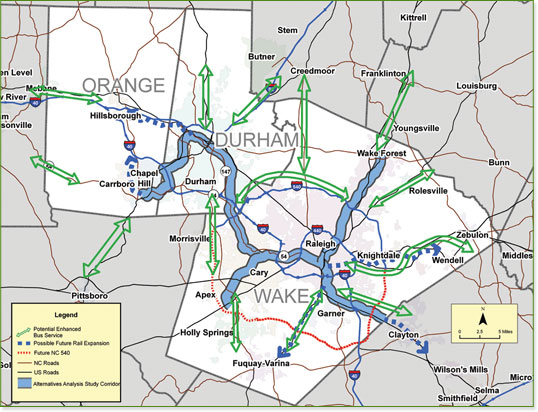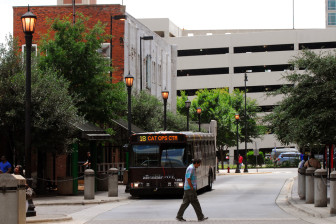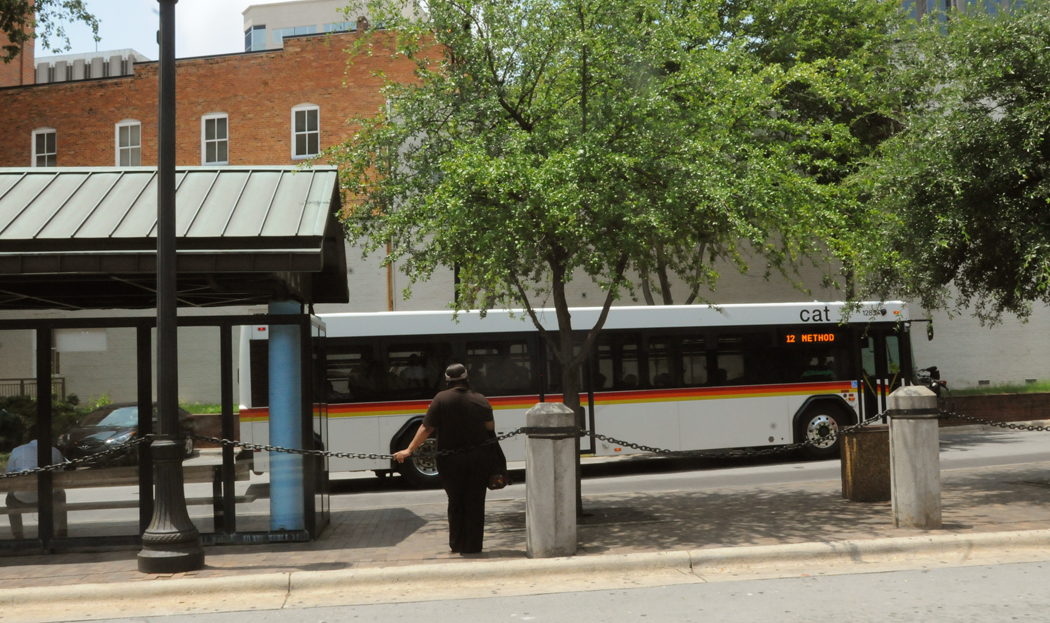A transit panel hired by Wake County doesn’t seem to see the big picture, Raleigh officials said recently.
A three-person panel hired by Wake County Commissioners spoke last week about the Wake County Transit Plan. While they said the plan has some merit, all said that the area was too small for rail and suggested enhancing bus service.
Raleigh staff and officials this week said the need for a plan is necessary — despite current metrics.
The panelists were commissioned after Wake Commissioner Paul Coble called for an independent review of the plan, to which he has long objected.
While panelists Steve Polzin, Sam Staley and Cal Marsella said they worked independently, all three came to the same general conclusions, which were presented at a public meeting Tuesday.
Polzin, Staley and Marsella said Wake County doesn’t have the congestion or current bus ridership to warrant an investment in rail. But, they said there is plenty of room for improvement in the current bus system that could be enhanced.
As ridership increases, new bus projects should be built with future rail in mind, they said.
Too Small for Rail
“You don’t have a transportation crisis,” said Polzin. “You have a transit opportunity.”
Polzin said that the current system is working well and that the region has some of the lowest congestion rates and commute times in the country.
“I can assure you that the vast majority of metro areas would die to have your roadway capacity metrics and congestion metrics and performance metrics,” he said.
Staley discussed layering transit systems and alternatives as the area grows. While he acknowledged the rapid growth in the Triangle, Staley said that the region hasn’t reached the density that makes it a large urban area.
“A lot of people are thinking large. You’re not there yet,” he said.
“In the grand scheme of things, the Raleigh-Durham metro area is still a medium-sized urban area,” Staley said. “You’re still very much in the beginning stages of growth.”
Outgoing Wake County Manager David Cooke said that the panelists were right to compare the region to other areas, but those numbers are all relative.
“If you’re sitting in traffic, then it’s relevant,” he said. “People aren’t going to necessarily compare it to Atlanta.”
Cooke said that crafters of the current plan looked at the area’s demographics, where it’s been, where it’s going and what people here think is important. He said the panel isn’t wrong in its assessment, but it offers another perspective.
Raleigh Mayor Nancy McFarlane reiterated that transit needs to be part of the plan if the area continues to grow as it is expected.
“We know what this area is going to be population-wise and business-wise in 2030,” she said. “That’s what we’re planning for.”

Commuter rail lines are part of the transit plan, but are not scheduled to be implemented for a few years.
Transit has always been part of the city’s 2030 Comprehensive Plan, which guides the future growth of the city. Some downtown companies such as Citrix and Red Hat are banking on enhanced transit coming to the area.
McFarlane said that transit offers more choices to future residents.
“If you don’t plan for the future then your choices are limited,” she said. “You’re boxed in by other people’s choices.”
Their plan is to get in front of the growth.
Raleigh’s Transportation Planning Manager Eric Lamb said that there was a lot of pragmatism in Tuesday’s discussion, but thinks the discussion lacked vision.
He said that the city recognizes the area is going to be a high-growth community, so planning for those services now and taking those first steps requires vision.
Lamb agreed with the panel’s suggestion to take incremental steps, such as protecting the right-of-way needed to eventually lay down rail.
“That requires you have a plan that you know exactly where these things are going to go,” said Lamb. “You have to develop the system plan for what you want to accomplish.”
On Board with Buses
While there was some disagreement as to whether the Triangle had the need for rail, there was general consensus on a need to enhance the bus system.
“I thought they had a good point,” Cooke said. “You have to build your ridership over time.”
Both Capital Area Transit and Triangle Transit have seen an increase in ridership, but panelists said more growth is needed before rail should be considered.
McFarlane said that the one thing everyone agrees with is the need to expand and enhance the current bus system — something the transit plan already addresses.

Karen Tam / Raleigh Public Record
“You have to have to have a strong bus system to support future expansion of transit,” said McFarlane. “That’s something that we’ve heard everywhere.”
Funding, however, remains an issue.
If approved by voters, the bulk of the half-cent sales tax increase associated with the current plan would primarily be used to fund expanded bus service throughout the county. The remainder would fund a commuter rail system.
Wake County Commissioners have yet to put the sales tax referendum on the ballot. Durham and Orange counties have both approved the increase, which will fund their own bus systems.
“The fact of the matter is, we’re still going to need the revenues to effectively implement the bus service,” Lamb said. “We are still going to need to have this conversation about additional revenue sources to fund better transit.”
Continued Discussion Unclear
The panel suggested county officials go back and look at the numbers to make sure they don’t have unrealistic expectations of cost and future ridership.
Those involved in the plan want to keep the conversation about transit on the table.
Despite calls from the public and other municipalities to hold a public hearing, this was the first public discussion on transit county officials have had since the plan was released two years ago.
Commissioners have made no public announcement as to when they plan to continue the discussion or make any decisions.
Raleigh Transit Administrator Dave Eatman said that many of Capital Area Transit’s existing plans already meet many of the objectives that were discussed by the panel.
“I think we’re ready to go no matter what happens in the future,” he said.
